Electromagnetic fields (EMF) have existed in different forms since the birth of the universe. Electromagnetic fields differ from each other by in relation to frequency, and visible light is their most familiar form.
Electric and magnetic fields are part of the electromagnetic spectrum which extends from static electric and magnetic fields, through radio frequency (RF), infrared radiation, and visible light to X and gamma-rays.
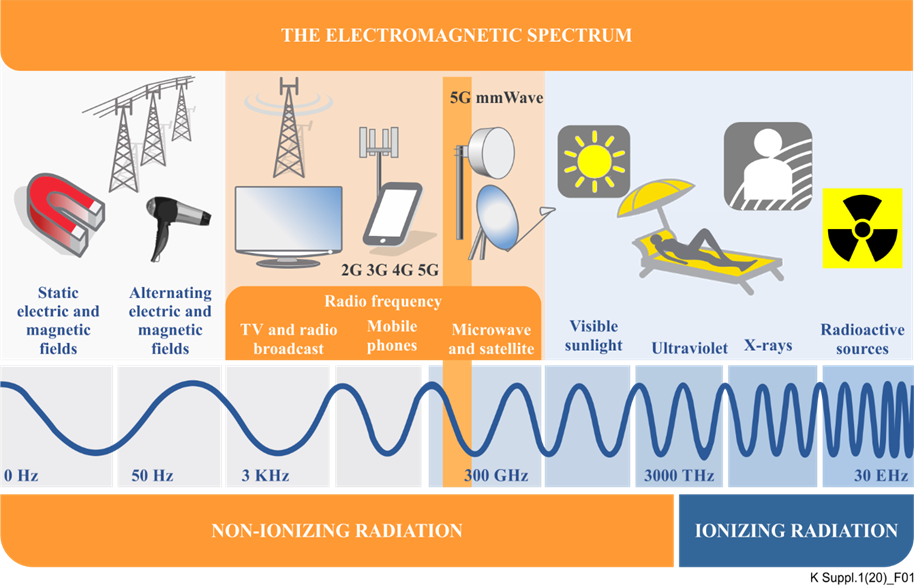
An electromagnetic field consists of waves of electric and magnetic energy moving together through space. Often the term "electromagnetic field" or EMF is used to indicate the presence of electromagnetic radiation.
A part of the electromagnetic spectrum extending from the 3 kHz frequency to 300 GHz is referred as radio frequency (RF). Television and radio transmitters (including base stations) as well as microwaves, mobile telephones and radars produce radio frequency fields. These fields are used to transmit information and form the basis of telecommunications as well as radio and television broadcasting all over the world. Many home devices such as cordless phones, baby monitors and radio-controlled toys, Wi-Fi, tablets, smart watches and other wireless devices also transmit EMF at radio frequencies.
Electromagnetic radiation at frequencies above the UV band are classified as "ionizing radiation", because they have enough energy to effect changes in the atoms by liberating electrons (ionizing) and thus altering their chemical bonds. X-rays and gamma rays are common forms of ionizing radiation.
Ionizing radiation occurs at frequencies above 2900 THz (2900×1012 Hz). This corresponds to a wavelength of about 103.4 nm, which lies near the lower wavelength-edge of the ultraviolet (UV) spectrum.
Electromagnetic radiation at frequencies below the UV band are classified as "non-ionizing radiation" because they lack the energy to liberate electrons i.e., to ionize or effect changes in atomic structure. Radio frequency fields are non-ionizing radiations.
Wireless communication technology has become an indispensable part of modern society. Mobile phones, tablets and wireless devices have become basic communication tools of everyday life for billions of people around the world, and are also common in medical applications. Base stations and telecommunications towers are continuously being erected to provide good quality wireless communications.
Together with the introduction of wireless communication technologies, there has been some degree of public concern about the potential health risks associated with wireless communications including the use of mobile phones and living near base stations.
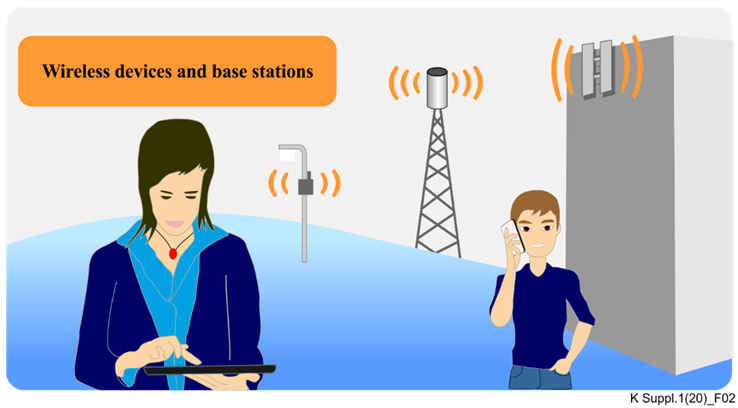
Electromagnetic fields (EMFs) of all frequencies represent one of the most common and fastest growing environmental influences. As part of its charter to protect public health and in response to public concern, the WHO established the International EMF Project in 1996. The purpose of the International EMF Project is to assess the scientific evidence of possible health effects of EMF in the frequency range from 0 to 300 GHz.
Further information on the WHO International EMF project is available at: WHO – Electromagnetic fields.
In terms of EMF and health the WHO notes:
The WHO notes that:
"While an increased risk of brain tumours is not established, the increasing use of mobile phones and the lack of data for mobile phone use over time periods longer than 15 years warrant further research of mobile phone use and brain cancer risk. In particular, with the recent popularity of mobile phone use among younger people, and therefore a potentially longer lifetime of exposure, WHO has promoted further research on this group. Several studes investigating potential health effects in children and adolescents are underway."
The WHO notes that:
"Studies to date provide no indication that environmental exposure to RF fields, such as from base stations, increases the risk of cancer or any other disease."
The ICNIRP advises:
The WHO notes:
The ICNIRP notes:
The IEEE notes:
Extensive research has been conducted into possible health effects of exposure to many parts of the electromagnetic spectrum.
As noted by the WHO, in the area of biological effects and medical applications of non-ionizing radiation approximately 25,000 articles have been published over the past 30 years. Despite the feeling of some people that more research needs to be done, scientific knowledge in this area is now more extensive than for most chemicals.
The WHO also references the EMF-Portal (www.emf-portal.org) which is a scientific literature database on the effects of electric, magnetic and electromagnetic fields on human health and biological systems. This open-access website is operated by the Research Center for Bioelectromagnetic Interaction (femu), part of the Institute of Occupational Medicine, RWTH Aachen University, Germany.
The EMF-Portal is, worldwide, the most comprehensive scientific literature database on biological and health-related effects of non-ionizing electromagnetic radiation (frequency range 0-300 GHz) with unrestricted access
The core of the EMF-Portal is an extensive literature database with an inventory of 31,031 publications and 6,716 summaries of individual scientific studies on the effects of electromagnetic fields, see Figure 3.
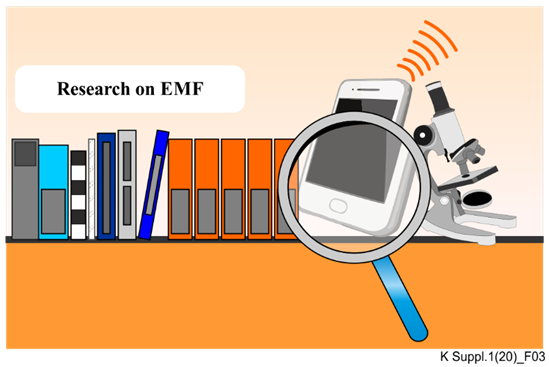
At frequencies above 10 MHz, the first scientifically-established effect to occur is heating. At frequencies below 10 MHz, the first effect to be experienced is non-thermal nerve stimulation (a tingling sensation).
 IARC classification of RF EMF
IARC classification of RF EMF
 Summary of the IARC classification of RF EMF
Summary of the IARC classification of RF EMF
 IARC World Cancer Report 2020
IARC World Cancer Report 2020
A mobile phone or wireless device is a low-power two way radio. It contains both a transmitter and a receiver and uses radio frequency fields to send and receive calls, access the Internet and send messages, and data.
When you make a call on a mobile phone or send or receive text messages or data, you are connected to a nearby base station through a radio frequency signal. The base station then communicates with the core of the network to a central exchange to determine where the call is to be forwarded to, then either your call is forwarded to the fixed line network and to an individual fixed land line phone, or if you are calling another mobile phone, your call will be forwarded to another base station and on to the mobile phone you are calling.
When you access data via your mobile device, the central exchange connects you to the internet.
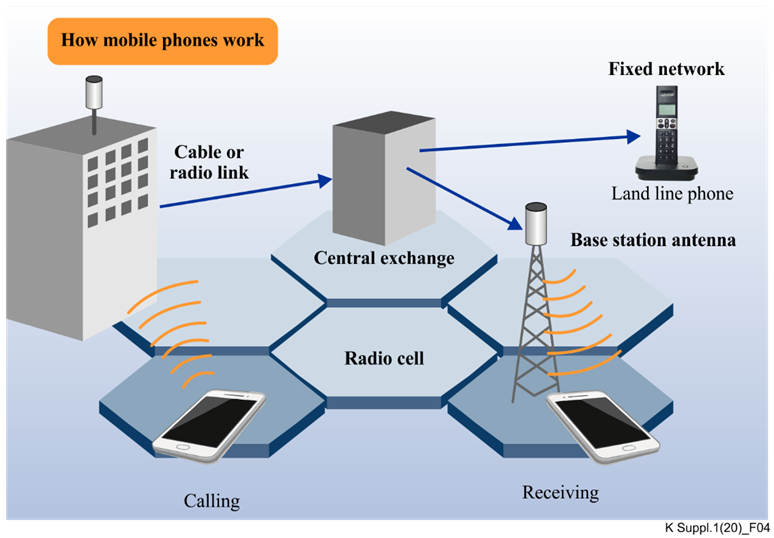
Base stations are low-power, multi-channel two-way radios located inside an equipment hut or cabinet. The base station antennas, which transmit and receive the radio signal, can be mounted on transmission towers, poles, roof-mounted structures or as small cells providing localized coverage. Base station radio transmitters typically operate at between 2-50 watts. In rural areas base stations may use additional power amplifiers for the transmitter and receiver to extend the coverage.
The location and positioning of the base station antennas are carefully chosen to match the required coverage area. Small base station antennas are often located inside buildings to provide dedicated indoor coverage.
The cellular mobile technology was introduced around 1980 and from that time it has evolved as new technologies have been developed. Figure 5 shows the evolution of applications for each technology.
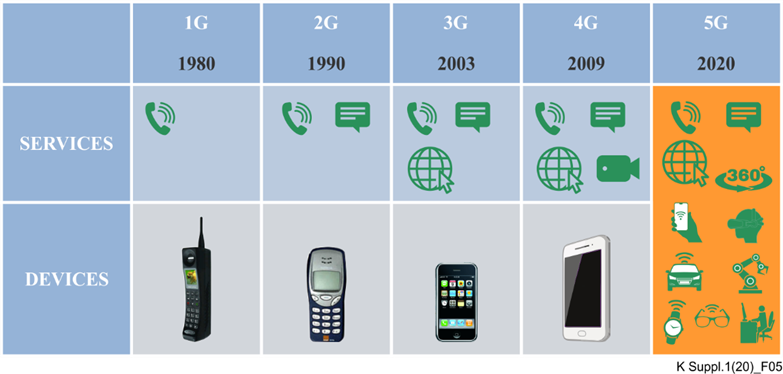
The key feature of each new technology is the increased spectral efficiency that allows transmission of more information using the same amount of resources including spectrum.
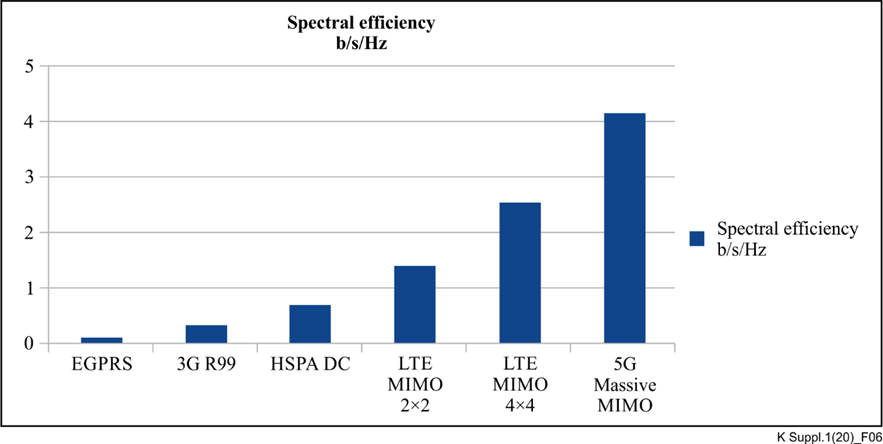
It's important to know the difference between antennas and towers. Towers are the structures to support the antennas. Like a street light where the brightness depends on distance from the light and not on its support pole. You need to keep your distance from the antennas that transmit the radio signal and not the towers that hold the antennas.
You also need to be aware of the many different designs of base stations that vary widely in their power and characteristics, affecting their potential for exposing people to RF signals. Research has shown that at ground level, the intensity of radio frequency signal from base stations are typically less than one thousandth of those from mobile phones.
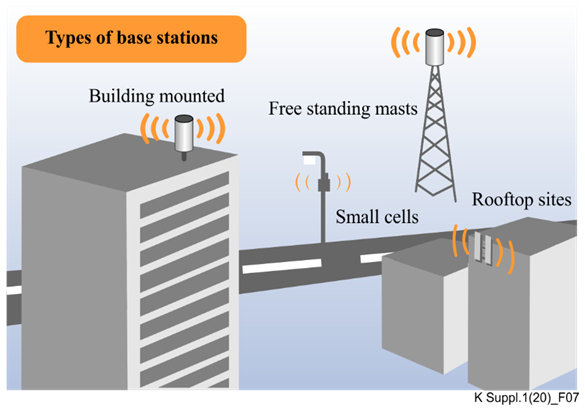
Yes. The power from a base station will vary depending on the number of mobile phone calls and amount data traffic being carried. In addition to the data and mobile phone calls, a pilot signal is continuously transmitted from the base station so that nearby mobile phones and wireless devices can detect the network. See references in clause 5.3 for additional information.
Mobile phones use low power transmitters that are less than two watts peak. Mobile phones are designed to automatically transmit at the lowest possible power to maintain a quality connection. This is a feature known as adaptive power control.
For more information refer to clause 6, Mobile Phones and EMF FAQ.
5G is the 5th generation of mobile networks. 5G has been designed to meet the very large growth in data and connectivity of today's modern society, the Internet of things (IoT) with billions of connected devices, and tomorrow's innovations.
5G technologies are expected to support applications such as smart homes and buildings, smart cities, 3D video, work and play in the cloud, remote medical services, virtual and augmented reality, and massive machine-to-machine communications for industry automation.
There are three major categories of use case for 5G:
Massive machine to machine communications – also called the Internet of things (IoT) that involves connecting billions of devices without human intervention at a scale not seen before. This has the potential to revolutionise modern industrial processes and applications including agriculture, manufacturing and business communications.
Ultra-reliable low latency communications – mission critical including real-time control of devices, industrial robotics, vehicle to vehicle communications and safety systems, autonomous driving and safer transport networks. Low latency communications also opens up a new world where remote medical care, procedures, and treatment are all possible
Enhanced mobile broadband – providing significantly faster data speeds and greater capacity keeping the world connected. New applications, as shown in Figure 8, will include fixed wireless Internet access for homes, outdoor broadcast applications without the need for broadcast vans, and greater connectivity for people on the move.

5G will initially operate in conjunction with existing 4G networks, as shown in Figure 9, before evolving to fully standalone networks in subsequent releases and coverage expansions.
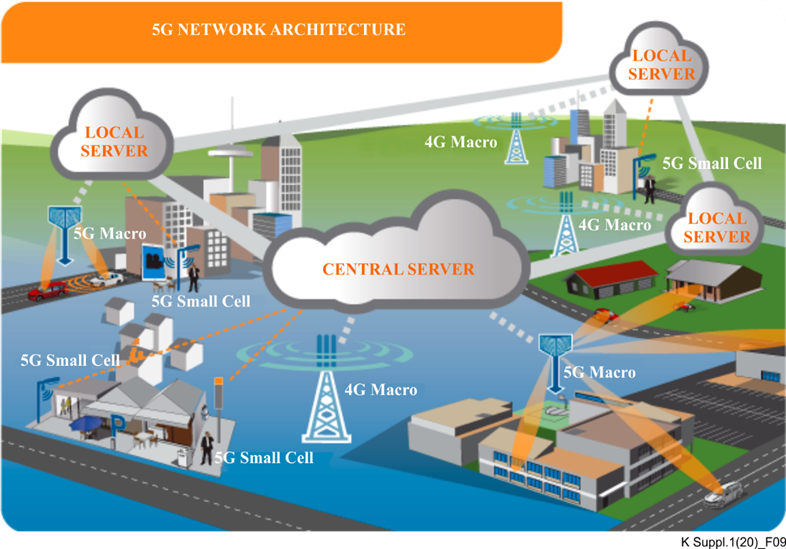
As depicted in Figure 9, a mobile network has two main components: the radio access network (RAN) and the core network.
The radio access network – consists of various types of facilities including small cells, towers, masts and dedicated in-building and home systems that connect mobile users and wireless devices to the main core network.
Small cells will be a major feature of 5G networks particularly at the new millimetre wave (mmWave) frequencies where the connection range is very short. To provide a continuous connection, small cells will be distributed in clusters depending on where users require connection which will complement the macro network that provides wide-area coverage.
5G macro cells will use multiple input, multiple output (MIMO) antennas that have multiple elements or connections to send and receive more data simultaneously. The benefit to users is that more people can simultaneously connect to the network and maintain high throughput. Where MIMO antennas use very large numbers of antenna elements they are often referred to as 'massive MIMO', however, the physical size is similar to existing 3G and 4G base station antennas.
The core network – is the mobile exchange and data network that manages all of the mobile voice, data and Internet connections. For 5G, the 'core network' is being redesigned to better integrate with the Internet and cloud based services and also includes distributed servers across the network improving response times (reducing latency).
Many of the advanced features of 5G including network function virtualization and network slicing for different applications and services, will be managed in the core. Figure 9 shows examples of local cloud servers providing faster content to users (movie streaming) and low latency applications for vehicle collision avoidance systems.
In many countries the initial frequency bands for 5G are below 6 GHz (in many cases in the 3.3-3.8 GHz bands) and similar frequencies to existing mobile and Wi-Fi networks. Additional mobile spectrum above 6 GHz, including the 26-28 GHz bands often referred to as millimetre wave (mmW), will provide significantly more capacity compared to the current mobile technologies. The additional spectrum and greater capacity will enable more users, more data and faster connections. 5G also uses the existing 2G, 3G and 4G low band spectrum for 5G as legacy networks decline in usage and to support future use cases. 5G is the next step in the evolution of the mobile technology and work has started on the development of the 6G standard.
The increased spectrum in the mmWave band will provide localized coverage as they only operate over short distances. Future 5G deployments may use mmW frequencies in bands up to 86 GHz.
Figure 10 shows spectrum used by mobile communication.
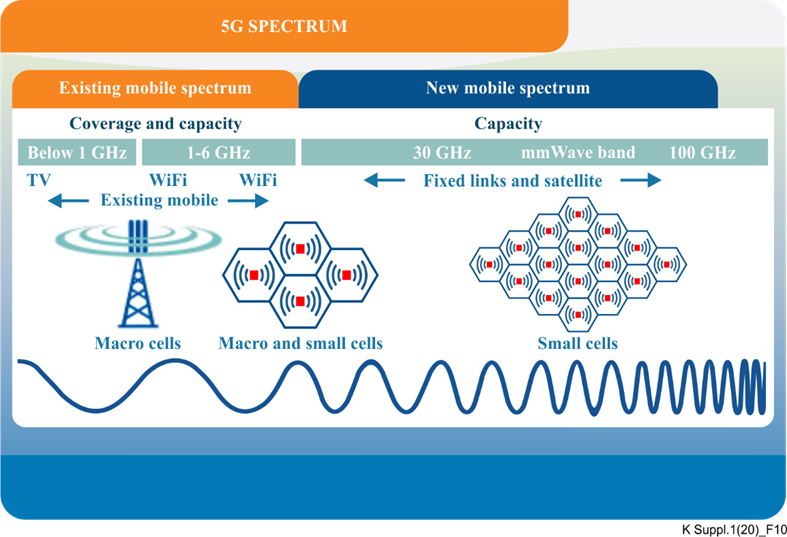
Beam steering, as shown in Figure 11, is a technology that allows the massive MIMO base station antennas to direct the radio signal to the users and devices rather than in all directions. The beam steering technology uses advanced signal processing algorithms to determine the best path for the radio signal to reach the user. This increases efficiency as it reduces interference (unwanted radio signals).
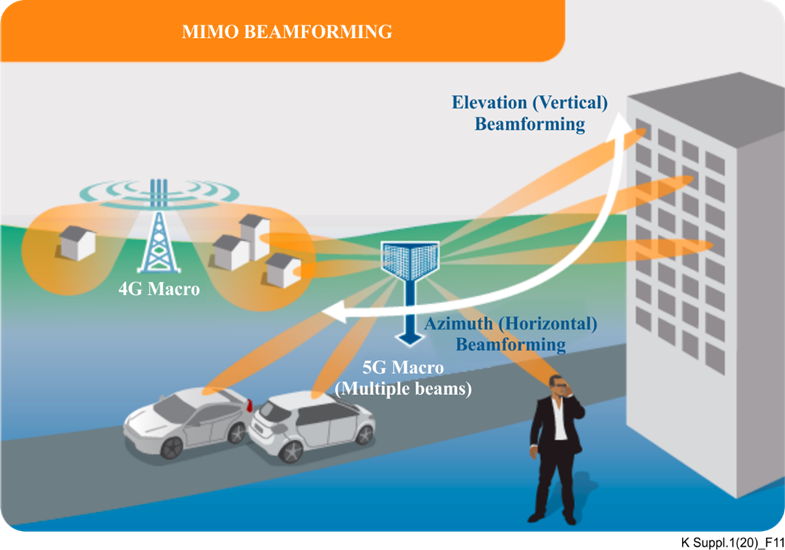
5G networks are designed to be more efficient and will use less power than current networks for similar services.
With the introduction of new technologies, there may be a small increase in the overall level of radio signals due to the fact that new transmitters are active. In some countries deployment of 5G may occur as part of closure of earlier wireless networks.
Based on the transition from previous wireless technologies we can expect that the overall exposure levels will remain relatively constant and a small fraction of the international exposure guidelines.
Initial surveys of 5G networks show very low exposure levels. ITU-T K-series Recommendations - Supplement 9 contains an analysis of the impact of the implementation of 5G mobile systems with respect to the exposure level of electromagnetic fields (EMFs) around radiocommunication infrastructure.
ITU Backgrounder – The ITU provides additional information on 5G in this backgrounder.
Specific absorption rate (SAR) is a measure of the amount of RF energy that is absorbed by tissues in the human body and expressed in watts per kg (W/kg). This measurement is used to determine whether or not a mobile phone complies with the safety standards or guidelines at frequencies below 6 GHz where RF energy is absorbed by tissues in the human body.
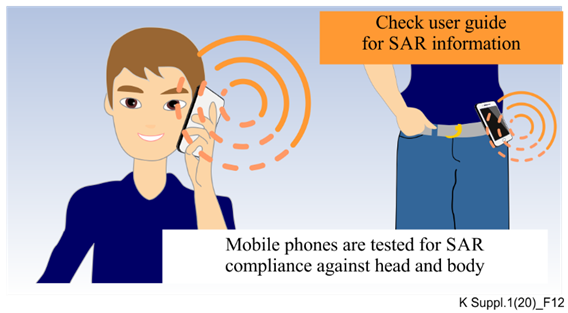
At frequencies above 6 GHz electromagnetic fields are absorbed more superficially in the human body making SAR assessments less relevant. The ICNIRP and IEEE human exposure guidelines describe human exposure in terms of the power density which is a measure of the power over a given area (W/m2).
Where a mobile device operates at frequencies below and above 6GHz, both SAR and power density must be assessed to determine compliance with the human exposure guidelines. This will typically apply to 5G devices that also operate in the mmWave frequency bands.
Additional information on 5G
ITU Backgrounder – The ITU provides additional information on 5G in this backgrounder.
The exposure from a mobile phone varies considerably during use due to adaptive power control and the connection back to the mobile network. A maximum exposure value measured in a laboratory does not provide sufficient information about the amount of RF exposure under typical usage conditions to reliably compare individual cell phone models. The level of exposure depends on the distance between the person and the mobile and the amount of RF power the mobile transmits.
Mobile devices will attempt to use the minimum amount of energy to provide a reliable service quality while at the same time preserving battery life, actual exposure varies continually depending on a range of factors including:
The distance between the person and the mobile device
RF fields are much weaker even a short distance from a mobile. Keeping the mobile away from the body by using an earpiece or loudspeaker function will significantly reduce exposure.
The distance from the base station
RF EMF from a mobile phone will vary its power level depending on its proximity to a base station using automatic power control. The closer it is to a base station, the less power is required - and conversely the further away it is, the more power is required (up to the phone's maximum SAR).
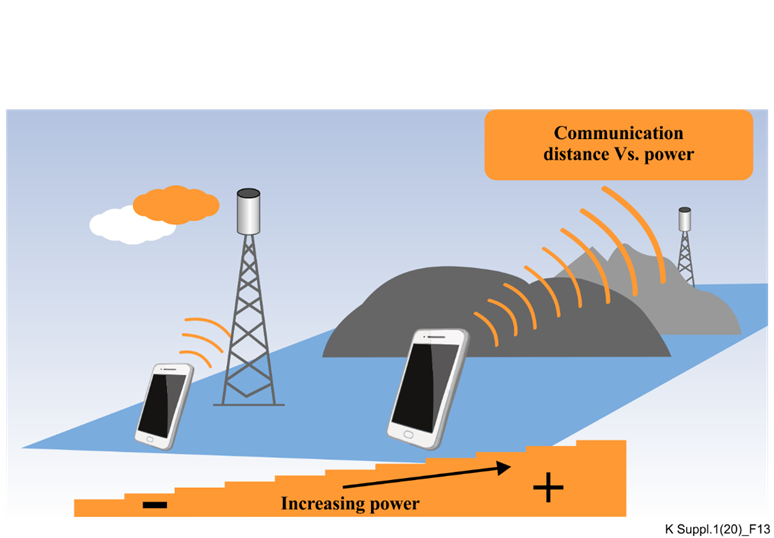
Obstacles between the user and the base station
If there is a building, wall, hill, tree or other obstruction between the mobile and the base station, the signal received by base station may also be weaker meaning the RF field strength from the mobile must increase so that it can still communicate with the base station.
The service being used
Making a voice call from a mobile phone could lead to greater exposure than sending and receiving data or accessing the Internet. This is because voice calls are generally made with the mobile phone next to the head, while it is typically held away from the body when sending and receiving data. Calls may also take longer than sending data, again increasing exposure. The time taken to write a text or email or to review information already stored on your mobile phone will not result in any significant exposure.
Exposure is related to actual communications with the network, such as during the sending of a message or continuously during a voice call. These higher levels of exposure as a result of a voice call are still less than the ICNIRP guidelines because all phones must comply with international safety standards. For more information refer to clause 5, Relevant EMF guidelines and standards.
Mobile phones are also designed to use the lowest possible power to connect to the nearest base station and automatically adjust the power depending on the environment.
Refer to ITU-T K-series Recommendations – Supplement 13 for additional information.
Mobile phone manufacturers must ensure that their products comply with the maximum SAR levels specified in the human exposure guidelines.
Mobile phones are tested for compliance at their highest possible power level through rigorous tests and multiple SAR measurements, therefore SAR values reported for each model of mobile phone tend to significantly overstate real-life exposure levels, as they rarely operate at maximum power levels during everyday use.
They are tested using both a 'phantom' head and a separate 'phantom' torso for body-worn measurements. The phantoms are filled with liquids that simulate the electrical properties of human tissue and SAR values are measured with the phone at maximum power at its different operating frequencies and in a range of positions.
A probe in a liquid measures the electric field strength inside the phantom and uses this to determine the maximum SAR value for the model of phone in each particular configuration.
As a result, the testing is both complex and time consuming. For full compliance testing, the process can take up to several weeks depending on the model in question.
A video showing the SAR testing procedure is available at http://www.emfexplained.info/?ID=25593.
Yes. The maximum SAR level for different mobile phone models can vary because the value is reported for demonstrating compliance with national and international limits. As such they are not directly comparable, but they demonstrate that the devices do comply with the relevant RF exposure limits.
New technologies increase RF efficiency and decreasepower; therefore, the EMF exposure from newer technology devices is lower for similar voice or data services.
No. Variations in the maximum reported SAR reflect different technical parameters such as the antenna used and its placement within the device. However these variations do not mean that there are variations in safety.
SAR is designed to demonstrate compliance with the relevant national or international limits. The declared maximum SAR value of a phone does not for example reflect the fact that once a call is established the mobile phone will power down to the minimum power level required to reach the base station and maintain a quality call.
The compliance information for a mobile phone should be available from the manufacturer's web site. This information and any other instructions on use should also be printed in the user manual that accompanies each mobile phone. Certain regulatory agencies provide the compliance information of mobile phones on their website.
A number of national and international organizations have formulated guidelines establishing limits for occupational and general public RF EMF exposure up to 300GHz.
 ICNIRP Guidelines ICNIRP Guidelines |
The exposure limits for EMF fields developed by the International Commission on Non-Ionizing Radiation Protection (ICNIRP) - a non-governmental organization in official relations with the WHO, were developed following reviews of all the peer-reviewed scientific literature, including thermal and non-thermal effects.
The guidelines are based on evaluations of biological effects that have been established to have health consequences. The main conclusion from the WHO reviews is that EMF exposures below the limits recommended in the  ICNIRP International Guidelines do not appear to have any known consequence on health. ICNIRP International Guidelines do not appear to have any known consequence on health.
ICNIRP has an ongoing program to monitor scientific research and ensure the human exposure guidelines are up to date. Visit the ICNIRP web site at http://www.icnirp.org |
| ICES/IEEE Safety Standards | The Institute of Electrical and Electronics Engineers (IEEE) is a professional association headquartered in New York City that is dedicated to advancing technological innovation and excellence, and includes the International Committee on Electromagnetic Safety (ICES) focused on development and maintenance of EMF Safety Standards. IEEE C95.1TM-2019 - Safety Levels with Respect to Human Exposure to Radio Frequency Electromagnetic Fields, 3 kHz to 300 GHz. |
Note:
The ICNIRP and IEEE guidelines are similar, science based and accepted in many countries around the world.
The ICNIRP guidelines use a range of mechanisms to ensure that all people are protected from RF EMF exposure. One of these is the use of reduction factors that ensure that the restrictions are far lower than are required to cause adverse health effectsfor all people. A reduction factor of 50 has been used for the general public, which results in an exposure that is too low to cause a detectable increase in body core temperature, and so would be protective for all groups. The wide safety margin ensures that any increase in body tissue temperature is negligible.
For workers, the limits are five times higher than those of the general public. The rationale for having lower limits for the general public is that this group includes children,pregnant women, the elderly and other persons of varying health status or susceptibility. In addition exposure might be continuous (24 hours a day) and people may be totally unaware of an exposure.
Recommendation ITU-T K.145 provides guidance on the assessment and management of compliance with radio frequency electromagnetic field exposure limits for workers at radiocommunication sites and facilities.
 Overview of the ITU
Overview of the ITU
Recommendation ITU-T K.52 - "Guidance on complying with limits for human exposure to electromagnetic fields"
Find supporting ammendments and software here.
Recommendation ITU-T K.61 - "Guidance on measurement and numerical prediction of electromagnetic fields for compliance with human exposure limits for telecommunication installations"
Recommendation ITU-T K.70 "Mitigation techniques to limit human exposure to EMFs in the vicinity of radiocommunication stations"
Find supporting ammendments and software here.
EMF Estimator is a software application that implements the methodology described in ITU-T K.70 to calculate the cumulative radio frequency exposure levels in the vicinity of transmitting antennas.
Recommendation ITU-T K.83 "Monitoring of electromagnetic field levels"
Find supporting errata here.
Recommendation ITU-T K.90 "Evaluation techniques and working procedures for compliance with exposure limits of network operator personnel to power-frequency electromagnetic fields"
Find supporting software here.
Recommendation ITU-T K.91 "Guidance for assessment, evaluation and monitoring of human exposure to radio frequency electromagnetic fields"
Recommendation ITU-T K.100 "Measurement of radio frequency electromagnetic fields to determine compliance with human exposure limits when a base station is put into service"
Recommendation ITU-T K.113 "Generation of radiofrequency electromagnetic fields level maps"
Recommendation ITU-T K.121 "Guidance on the environmental management for compliance with radio frequency EMF limits for radiocommunication base stations"
Recommendation ITU-T K.122 "Exposure levels in close proximity of radiocommunication antennas"
Recommendation ITU-T K.145 "Assessment and management of compliance with radio frequency electromagnetic field exposure limits for workers at radiocommunication sites and facilities"
Find supporting software here.
Recommendation ITU-R BS.1698 "Evaluating fields from terrestrial broadcasting transmitting systems operating in any frequency band for assessing exposure to non-ionizing radiation"
 Report ITU-D Question 23/1 "Strategies and policies concerning human exposure to Electromagnetic fields"
Report ITU-D Question 23/1 "Strategies and policies concerning human exposure to Electromagnetic fields"
 ITU-R Handbook "Spectrum Monitoring"
ITU-R Handbook "Spectrum Monitoring"
ITU-T K Suppl. 4 "Electromagnetic field considerations in smart sustainable cities"
 ITU-T K Supl. 9 "5G technology and human exposure to radiofrequency electromagnetic fields"
ITU-T K Supl. 9 "5G technology and human exposure to radiofrequency electromagnetic fields"
 ITU-T K Supl. 13 "Radiofrequency electromagnetic field (RF-EMF) exposure levels from mobile and portable devices during different conditions of use"
ITU-T K Supl. 13 "Radiofrequency electromagnetic field (RF-EMF) exposure levels from mobile and portable devices during different conditions of use"
 ITU-T K Supl. 14 "The impact of RF-EMF exposure limits stricter than the ICNIRP or IEEE guidelines on 4G and 5G mobile network deployment"
ITU-T K Supl. 14 "The impact of RF-EMF exposure limits stricter than the ICNIRP or IEEE guidelines on 4G and 5G mobile network deployment"
 ITU-T K Supl. 16 "Electromagnetic field compliance assessments for 5G wireless networks"
ITU-T K Supl. 16 "Electromagnetic field compliance assessments for 5G wireless networks"
 ITU-T K Supl. 19 "Electromagnetic field (EMF) strength inside underground railway trains"
ITU-T K Supl. 19 "Electromagnetic field (EMF) strength inside underground railway trains"
IEC Standards are developed by the International Electrotechnical Commission. The IEC is a not-for-profit, non-governmental organization, founded in 1906. The IEC's members are National Committees, and they appoint experts and delegates coming from industry, government bodies, associations and academia to participate in the technical and conformity assessment work of the IEC.
IEC Technical Committee 106 is responsible for preparing international standards on measurement and calculation methods to assess human exposure to electric, magnetic and electromagnetic fields.
A list of the relevant IEC standards is available from the IEC TC106 web site.
Note: The IEC and ICNIRP have agreed on the sharing of responsibilities for EMF standards. EMF exposure limits guidelines are developed by ICNIRP and EMF exposure assessment standards developed by IEC.
The IEEE also prepares compliance assessment standards for electromagnetic fields in the frequency range 3 kHz to 300 GHz. The relevant IEEE standards for EMF are available from the IEEE web site using "EMF" in the search box on the web site.
The IEC and IEEE also have a formal sharing arrangement. Based on the dual-logo agreement between IEC and IEEE, in the future the EMF compliance assessment standards developed by the IEC will also carry the IEEE logo, i.e. will become IEEE standards.
 What are the health risks associated with mobile phones and their base stations?
What are the health risks associated with mobile phones and their base stations?
 What is 5G?
What is 5G?
 What are the main differences between 5G and previous technologies?
What are the main differences between 5G and previous technologies?
 What are the potential health risks from 5G?
What are the potential health risks from 5G?
 What are the International Exposure Guidelines?
What are the International Exposure Guidelines?
 What is WHO doing?
What is WHO doing?
 Do mobile phones emit radiation?
Do mobile phones emit radiation?
 How much power does a mobile phone transmit?
How much power does a mobile phone transmit?
 How does Adaptive Power Control Work?
How does Adaptive Power Control Work?
 Does the EMF from my mobile vary?
Does the EMF from my mobile vary?
 What are the exposure levels from mobile phones?
What are the exposure levels from mobile phones?
 What is the typical power of a mobile?
What is the typical power of a mobile?
 How can I reduce exposure from my mobile?
How can I reduce exposure from my mobile?
 Do mobile phone shields reduce exposure?
Do mobile phone shields reduce exposure?
 Do mobiles radiate less EMF when close to a base station?
Do mobiles radiate less EMF when close to a base station?
 Do mobiles have less EMF when the signal display has full bars?
Do mobiles have less EMF when the signal display has full bars?
 Does texting have lower exposure compared to calls?
Does texting have lower exposure compared to calls?
 Are we at a high risk of EMF exposure when using mobile phones inside high speed transportation?
Are we at a high risk of EMF exposure when using mobile phones inside high speed transportation?
 Is using a mobile phone in the car or at home safer because these constitute a barrier to radiation?
Is using a mobile phone in the car or at home safer because these constitute a barrier to radiation?
 Are children more vulnerable to the EMF from mobile phones than adults?
Are children more vulnerable to the EMF from mobile phones than adults?
 What are the EMF levels around base stations?
What are the EMF levels around base stations?
 Is it safe to live near a base station or locate base stations near schools or hospitals?
Is it safe to live near a base station or locate base stations near schools or hospitals?
 Do more base stations reduce EMF?
Do more base stations reduce EMF?
 Is it safe to locate base stations on hospitals?
Is it safe to locate base stations on hospitals?
 Are there restricted areas in front of base station antennas?
Are there restricted areas in front of base station antennas?
 Who sets the EMF human exposure limits and standards?
Who sets the EMF human exposure limits and standards?
 Is there a safety margin built into the human exposure limits?
Is there a safety margin built into the human exposure limits?
 Are children and pregnant women protected by the safety standard?
Are children and pregnant women protected by the safety standard?
 Are people with electronic implants protected by the safety standard?
Are people with electronic implants protected by the safety standard?
 Is it possible to cook an egg or grains of corn using a mobile phone?
Is it possible to cook an egg or grains of corn using a mobile phone?
 Is the power output of a mobile phone enough to make the brain boil?
Is the power output of a mobile phone enough to make the brain boil?
 Does use of a mobile phone attract lightning?
Does use of a mobile phone attract lightning?
 Can a mobile phone cause a gas station to catch fire?
Can a mobile phone cause a gas station to catch fire?
As part of its mandate, ITU carries out a series of activities on human exposure to electromagnetic fields.
ITU-T Activities on EMF ITU-T EMF Flyer
ITU-T EMF Flyer
The ITU (International Telecommunication Union) is the United Nations specialized agency for information and communication technologies (ICTs).
This Guide has been developed by ITU with the contribution of its membership which comprises governments, private sector entities and academic institutions.
This Guide will be regularly updated based on new information or research made available by ITU and WHO.
For additional information, please contact ITU-T Study Group 5 (tsbsg5@itu.int)
International Telecommunications Union https://www.itu.int
World Health Organization WHO – Electromagnetic fields
EMF Explained Series http://www.emfexplained.info
Mobile Manufacturers Forum http://www.sartick.com/
GSM Association http://www.gsma.com/health
Australian Mobile Telecommunications Association http://www.amta.org.au/